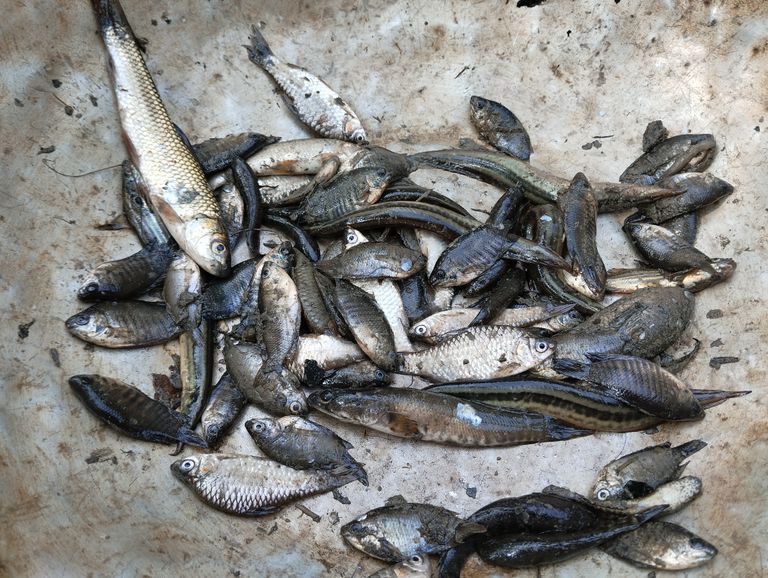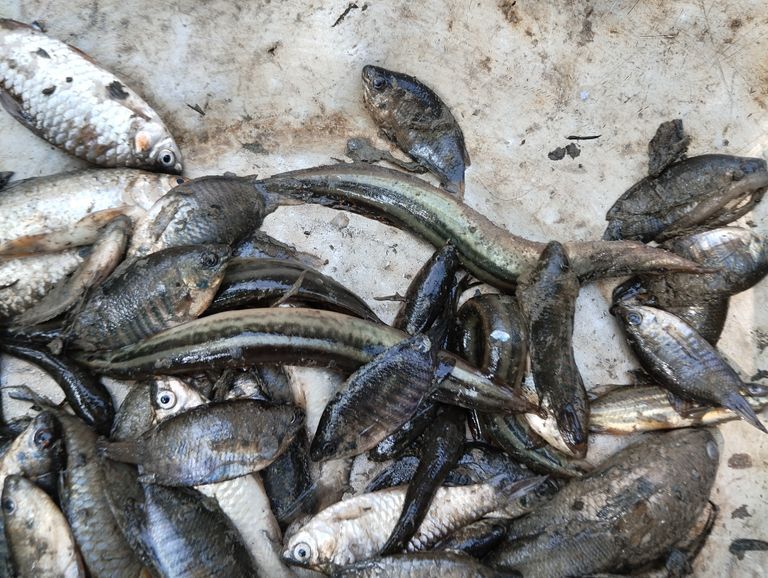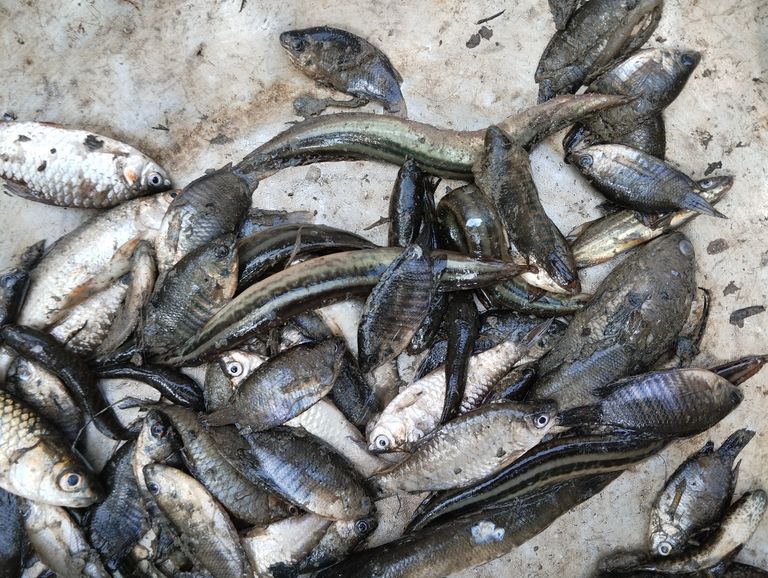Health Benefits of Eating Small Fish.

Fish has always been considered one of the healthiest protein sources, but small fish, in particular, come with unique benefits. Rich in essential nutrients, small fish like anchovies, sardines, mackerel, and small indigenous species provide numerous health advantages that make them a valuable addition to your diet. This blog explores the incredible health benefits of eating small fish and why you should consider incorporating them into your meals regularly.
Rich Source of Omega-3 Fatty Acids
Small fish are an excellent source of omega-3 fatty acids, which play a crucial role in maintaining heart and brain health. These essential fatty acids help reduce inflammation, lower blood pressure, and decrease the risk of heart disease. Since small fish are consumed whole, including their bones and skin, they provide a more concentrated source of omega-3s than larger fish.
High in Protein with Low Calories
Protein is essential for muscle growth, repair, and overall body function. Small fish offer high-quality protein without excessive calories, making them an excellent choice for those looking to maintain a healthy weight. Unlike red meat, which can be high in saturated fat, small fish provide lean protein with minimal fat content.
Excellent Source of Calcium and Phosphorus
One of the biggest advantages of eating small fish is that they are consumed with their bones, which are rich in calcium and phosphorus. These minerals are crucial for maintaining strong bones and teeth, preventing osteoporosis, and ensuring proper muscle and nerve function. Regular consumption of small fish can significantly contribute to your daily calcium intake, especially for individuals who do not consume enough dairy products.
Loaded with Essential Vitamins and Minerals
Small fish are packed with essential vitamins and minerals that contribute to overall well-being:
Vitamin D – Supports bone health and boosts the immune system.
Vitamin B12 – Essential for brain function and the production of red blood cells.
Iodine – Supports thyroid function and hormone regulation.
Iron – Helps prevent anemia and supports oxygen transport in the body.
Magnesium – Aids muscle relaxation and cardiovascular health.
Eating small fish regularly ensures that your body receives a well-balanced combination of these nutrients.
Supports Heart Health
Consuming small fish regularly can help reduce the risk of cardiovascular diseases. Omega-3 fatty acids present in small fish reduce bad cholesterol (LDL) levels while increasing good cholesterol (HDL). They also help in preventing blood clots, reducing inflammation, and improving overall heart function.
Studies have shown that individuals who consume fish regularly have a lower risk of heart attacks and strokes. Since small fish have lower mercury levels than larger fish, they are a safer and healthier choice for heart health.
Boosts Brain Function and Mental Health
The omega-3 fatty acids found in small fish are not only beneficial for the heart but also for brain function. DHA (Docosahexaenoic Acid), a type of omega-3, plays a crucial role in cognitive development, memory retention, and mental health.
Regular consumption of small fish may help reduce the risk of neurodegenerative diseases like Alzheimer's and Parkinson’s. Additionally, omega-3s have been shown to improve mood and reduce symptoms of depression and anxiety.
Improves Eye Health
The high concentration of omega-3 fatty acids and vitamin A in small fish helps improve vision and protect against age-related eye diseases. Regular consumption of small fish can reduce the risk of conditions such as macular degeneration and dry eye syndrome.
Environmentally Sustainable Choice
Eating small fish is not only beneficial for health but also for the environment. Since small fish reproduce quickly and exist in large numbers, they are a more sustainable choice compared to larger predatory fish. Overfishing of larger fish species has led to ecological imbalances, while consuming small fish can help maintain the natural food chain and ensure ocean sustainability.
Low in Mercury and Other Contaminants
Larger fish, such as tuna and swordfish, tend to accumulate higher levels of mercury and other harmful contaminants over time. In contrast, small fish have shorter life spans, which means they accumulate significantly lower levels of toxins. This makes them a safer and healthier seafood option, particularly for pregnant women and young children.
Affordable and Easily Available
Small fish are generally more affordable than larger fish or other sources of animal protein. They are widely available in local markets and can be prepared in various ways, making them a cost-effective and nutritious option for people from different economic backgrounds.
How to Include Small Fish in Your Diet
There are many delicious ways to incorporate small fish into your diet:
Fried or grilled – A simple way to enjoy crispy and flavorful fish.
Stews and curries – Enhances taste and nutrition in traditional dishes.
Smoked or dried – Preserved fish can be used in soups and stir-fries.
Pickled – Adds a tangy and unique flavor to meals.
Salads – Fresh or canned small fish can be added to salads for an extra boost of protein and healthy fats.
Regardless of how they are prepared, small fish are a delicious and nutritious addition to any diet.
Conservation and Ethical Fishing
Catch and Release: If you don’t need the fish, release them safely.
Avoid Overfishing: Take only what you need.
Use Eco-Friendly Equipment: Avoid plastic pollution in water bodies.
Fishing for small fish is an enjoyable and useful skill. Whether using a fishing rod, net, or trap, the right technique and patience will help you catch fish effectively. Respect nature, follow local rules, and enjoy your fishing experience!
Would you like more details on any specific method?
Small fish are a powerhouse of essential nutrients, offering immense health benefits ranging from improved heart and brain function to strong bones and better eye health. Their affordability, availability, and environmental sustainability make them an excellent choice for people worldwide. Whether you enjoy them fresh, dried, or canned, adding small fish to your diet is a simple way to enhance your overall health and well-being. So, the next time you're looking for a nutritious meal, consider small fish – a small but mighty addition to a healthy lifestyle.
Delicious Small Fish Curry Recipe
Small fish dishes are a staple in many cuisines, especially in South Asia. These fishes are not only tasty but also packed with essential nutrients like Omega-3, calcium, and protein. Cooking small fish can be simple yet delicious when done right. This blog will guide you through a flavorful and easy-to-make small fish curry recipe that pairs perfectly with steamed rice.
Why Cook Small Fish?
Small fish, such as anchovies, sprats, or small mackerel, are a great addition to your diet. They are usually eaten whole, which means you get the added benefit of calcium from their tiny bones. Unlike larger fish, small fish have lower mercury content, making them a healthier choice.


Ingredients:
To prepare a delicious small fish curry, you will need:
For Cleaning & Marination:
500 grams of small fish (such as anchovies, sprats, or small mackerel)
½ teaspoon turmeric powder
½ teaspoon salt
1 tablespoon lemon juice
For the Curry:
2 tablespoons mustard oil (or any cooking oil)
1 teaspoon mustard seeds
1 bay leaf
2 onions (finely chopped)
2 tomatoes (finely chopped)
1 tablespoon ginger-garlic paste
2 green chilies (slit)
1 teaspoon cumin powder
1 teaspoon coriander powder
½ teaspoon red chili powder (adjust to taste)
½ teaspoon turmeric powder
1 teaspoon garam masala
½ teaspoon salt (or to taste)
1 cup coconut milk or water
Fresh coriander leaves (for garnish)
Step-by-Step Cooking Instructions
Step 1: Cleaning & Marinating the Fish
Wash the small fish thoroughly under running water. If needed, remove the heads and guts.
Sprinkle turmeric powder, salt, and lemon juice over the fish. Mix well and let it marinate for 15–20 minutes.
Step 2: Frying the Fish (Optional but Recommended)
Heat a little oil in a pan and shallow-fry the marinated fish for 2–3 minutes on each side. This enhances the texture and flavor of the curry. Set aside.
Step 3: Preparing the Curry Base
In the same pan, add mustard oil. Once hot, add mustard seeds and a bay leaf. Let them splutter.
Add finely chopped onions and sauté until they turn golden brown.
Stir in the ginger-garlic paste and cook for a minute until the raw smell disappears.
Add chopped tomatoes and green chilies. Cook until the tomatoes become soft and oil starts to separate.
Step 4: Cooking the Curry
Add cumin powder, coriander powder, red chili powder, turmeric, and garam masala. Stir well.
Pour in a cup of coconut milk or water and bring it to a boil.
Gently add the fried (or raw) small fish to the curry. Simmer for 5–7 minutes until the fish is cooked and absorbs the flavors.
Adjust salt if needed and let it cook for another 2 minutes.
Step 5: Garnishing & Serving
Turn off the heat and garnish with fresh coriander leaves.
Serve hot with steamed rice or roti for a wholesome meal.
Tips for the Best Small Fish Curry:
Use fresh fish: Fresh fish gives the best flavor and texture. If using frozen fish, thaw it completely before cooking.
Frying enhances taste: Lightly frying the fish before adding it to the curry prevents breakage and enhances the flavor.
Adjust spice levels: If you prefer a milder curry, reduce the chili powder and green chilies.
Coconut milk adds richness: Using coconut milk gives the curry a creamy and slightly sweet taste. If unavailable, regular water works well too.
Health Benefits of Small Fish:
Rich in Omega-3 fatty acids: Helps improve heart health.
High in calcium: Good for bone strength.
Low in mercury: Safer than larger fish varieties.
Boosts immunity: Contains essential vitamins and minerals.
Variations to Try:
Spicy Dry Small Fish Fry: Instead of making a curry, you can dry-fry the marinated fish with onions, chilies, and spices for a crispy dish.
Tangy Tamarind Fish Curry: Add tamarind pulp for a tangy and sour twist to the dish.
Coconut & Mustard Fish Curry: Blend mustard seeds with coconut for a Bengali-style mustard fish curry.
Final Thoughts
Small fish curry is a simple yet flavorful dish that is easy to prepare. Whether you enjoy it with steamed rice or as a side dish, its rich taste and health benefits make it a must-try. So, the next time you have small fish, give this recipe a shot and enjoy a delicious homemade meal. Let me know if you try this recipe or have any variations of your own! Happy cooking.
Small Fish Catching Techniques: A Complete Guide
Fishing for small fish can be both relaxing and rewarding. Whether you’re catching baitfish, fishing for fun, or learning survival skills, knowing the right techniques makes all the difference. In this guide, we’ll explore the best methods, tools, and tips for catching small fish effectively.
Choosing the Right Location
The success of fishing depends on selecting the right fishing spot. Small fish are usually found in:
Ponds and Lakes: Near vegetation and shallow areas.
Rivers and Streams: In slow-moving water and near rocks.
Canals and Ditches: Common habitats for small freshwater fish.
Seashores and Estuaries: Best for catching small saltwater fish.
Best Time to Catch Small Fish
Early Morning & Late Afternoon: Fish are more active and searching for food.
Cloudy or Overcast Days: Fish feel safer from predators and are more likely to bite.
Equipment Needed for Small Fish Catching
Fishing Rod & Line
A lightweight fishing rod with a thin fishing line (2-6 lb test) is ideal for catching small fish.
Hooks & Bait
Small Hooks (Size 10-20): Needed to hook small fish.
Baits: Worms, bread, insects, or tiny artificial lures work best.
Fishing Nets & Traps
Hand Nets: Useful for scooping fish in shallow water.
Cast Nets: Perfect for catching multiple small fish at once.
Fish Traps: Simple traps made of wire or bamboo can passively catch fish.
Effective Techniques for Catching Small Fish
A. Hook and Line Fishing
This is the most common method. Follow these steps:
Attach a small hook to the fishing line.
Use a tiny piece of bait (worm, bread, or insect).
Drop the bait into the water and wait for a bite.
Gently pull the fish out when it bites.
B. Net Fishing
Casting Net Method: Throw a circular net into the water and pull it back to trap fish.
Scoop Net Method: Slowly drag a hand net through shallow water.
C. Trap Fishing
Place a fish trap in a known fish area.
Use bait inside the trap to attract fish.
Check the trap after a few hours to collect the fish.
D. Hand Fishing (Survival Method)
If no tools are available, use your hands to catch fish by slowly approaching them in shallow water and scooping them up.
Best Baits for Small Fish
Live Baits: Worms, insects, mosquito larvae, small shrimp.
Artificial Lures: Tiny soft plastics, jigs, or spinners.
Homemade Baits: Bread balls, rice dough, or crushed biscuits.
Tips for Successful Small Fish Catching
Use the Right Equipment: Small hooks and light lines increase success.
Stay Quiet & Move Slowly: Avoid scaring the fish.
Fish in the Right Places: Near plants, rocks, or underwater structures.
Change Bait if Needed: If fish are not biting, try different bait.
Check Local Regulations: Ensure fishing is allowed in your area.
Conservation and Ethical Fishing
Catch and Release: If you don’t need the fish, release them safely.
Avoid Overfishing: Take only what you need.
Use Eco-Friendly Equipment: Avoid plastic pollution in water bodies.
Fishing for small fish is an enjoyable and useful skill. Whether using a fishing rod, net, or trap, the right technique and patience will help you catch fish effectively. Respect nature, follow local rules, and enjoy your fishing experience. Would you like more details on any specific method?
Small Fish Catching Techniques: A Complete Guide
Fishing for small fish can be both relaxing and rewarding. Whether you’re catching baitfish, fishing for fun, or learning survival skills, knowing the right techniques makes all the difference. In this guide, we’ll explore the best methods, tools, and tips for catching small fish effectively.
Choosing the Right Location
The success of fishing depends on selecting the right fishing spot. Small fish are usually found in:
Ponds and Lakes: Near vegetation and shallow areas.
Rivers and Streams: In slow-moving water and near rocks.
Canals and Ditches: Common habitats for small freshwater fish.
Seashores and Estuaries: Best for catching small saltwater fish.
Best Time to Catch Small Fish
Early Morning & Late Afternoon: Fish are more active and searching for food.
Cloudy or Overcast Days: Fish feel safer from predators and are more likely to bite.
Equipment Needed for Small Fish Catching
Fishing Rod & Line
A lightweight fishing rod with a thin fishing line (2-6 lb test) is ideal for catching small fish.
Hooks & Bait
Small Hooks (Size 10-20): Needed to hook small fish.
Baits: Worms, bread, insects, or tiny artificial lures work best.
Fishing Nets & Traps
Hand Nets: Useful for scooping fish in shallow water.
Cast Nets: Perfect for catching multiple small fish at once.
Fish Traps: Simple traps made of wire or bamboo can passively catch fish.
Effective Techniques for Catching Small Fish
A. Hook and Line Fishing
This is the most common method. Follow these steps:
Attach a small hook to the fishing line.
Use a tiny piece of bait (worm, bread, or insect).
Drop the bait into the water and wait for a bite.
Gently pull the fish out when it bites.
B. Net Fishing
Casting Net Method: Throw a circular net into the water and pull it back to trap fish.
Scoop Net Method: Slowly drag a hand net through shallow water.
C. Trap Fishing
Place a fish trap in a known fish area.
Use bait inside the trap to attract fish.
Check the trap after a few hours to collect the fish.
D. Hand Fishing (Survival Method)
If no tools are available, use your hands to catch fish by slowly approaching them in shallow water and scooping them up.
Best Baits for Small Fish
Live Baits: Worms, insects, mosquito larvae, small shrimp.
Artificial Lures: Tiny soft plastics, jigs, or spinners.
Homemade Baits: Bread balls, rice dough, or crushed biscuits.
Tips for Successful Small Fish Catching
Use the Right Equipment: Small hooks and light lines increase success.
Stay Quiet & Move Slowly: Avoid scaring the fish.
Fish in the Right Places: Near plants, rocks, or underwater structures.
Change Bait if Needed: If fish are not biting, try different bait.
Check Local Regulations: Ensure fishing is allowed in your area.